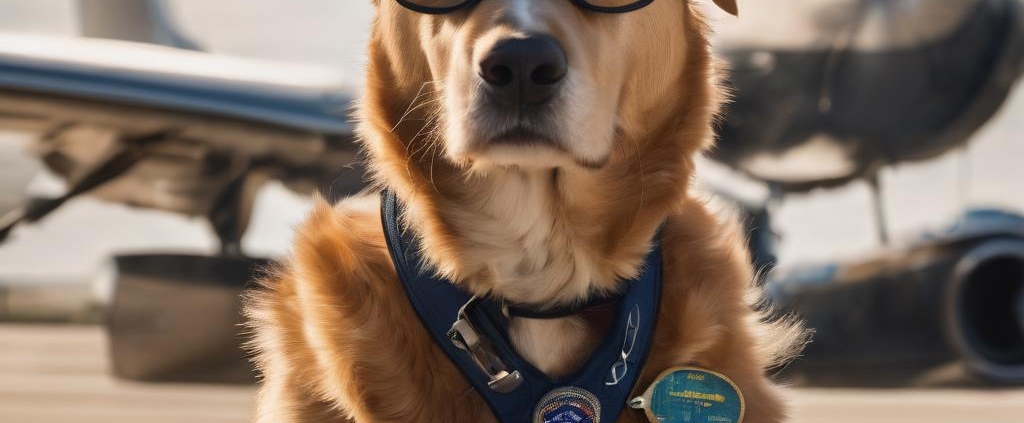Flying With Dogs: Navigating US Air Travel Regulations
The only thing that comes between you and a thrilling adventure with your furry companion is a load of rules and regulations – which can be overwhelming. To help you out in this blog, we will talk about the pointers handed down by the USDA for those thinking about flying with their dogs.
If you’re wondering what USDA stands for, it is the United States Department of Agriculture (USDA) that is responsible for ensuring the safety and comfort of our four-legged pals during travels. And for those of you who are scared of traveling with pets alone, we’ll also provide you with the best solution for a hassle-free flying experience with dogs.
Setting The Stage For Pet Travel Within The U.S
When traveling with your beloved pet, it is best to contact the airline in advance. Contact them directly and confirm if there’s available space for your pet on the date you wish to schedule your flight. Don’t forget to re-confirm your pet’s travel plans with the airline about 24 to 48 hours prior to departure. While advance arrangements can help secure your pet’s spot, remember that airlines reserve the right to refuse transport for various reasons, including improper carriers, or aggressive behavior.
To avoid such complications, make sure you have the right travel crate for dogs and familiarize your pet with it in the weeks leading up to the trip. Take your dog on short trips around town in the carrier to help them get comfortable. However, it’s important to note that airlines have strict rules against unaccompanied minors flying with dogs.
Preparing Your Pet For Travel
On the day of your flight, the USDA mandates certain guidelines to ensure your pet’s well-being. Within four hours before check-in, offer your pet food and water. This will hopefully make them a little comfier for their journey ahead!
Physical activity is crucial, so exercise your furry friend before heading to the airport. Walking your dog with a leash on can help them remain calm before and after the flight. Arriving at the airport early is essential, but remember not to check your pet in more than four hours before the flight. Most pet friendly airlines recommend arriving two hours before departure when flying with dogs, and check-in must be done at the ticket counter.
Approved Travel Crates For Dogs
Selecting an appropriate carrier is paramount for ensuring safety when flying with dogs. The majority of carriers are made of hard plastic with adequate ventilation. Wire carriers are not permitted, as no part of the animal should protrude. Soft-sided carriers are only allowed for in-cabin pet travel. The carrier should allow your pet to stand, turn around, and lie down comfortably.
Ensure the carrier has a leak-proof floor with an absorbent lining and proper ventilation openings. Grips or handles are necessary, and the carrier must contain dishes for food and water, along with feeding instructions and your signature certifying your pet’s recent feed. Mark the carrier with identification tags and “Live Animal” markings, indicating proper positioning.
Health Certificates For Safe Travel
Health is a top priority when flying with dogs. The USDA requires pets to be at least eight weeks old and fully weaned before travel. A valid health certificate from a licensed veterinarian, issued within 30 days of travel, is mandatory for all pets crossing state borders, excluding guide dogs. When traveling via cargo or for a breeder, dealer, or research facility, the health certificate should be issued within 10 days of departure.
Tranquilizers For Your Dog’s Safety During Flights
Sedating pets before a flight is generally discouraged due to the potential risks. Sedation alters a pet’s balance and equilibrium, which can be unsafe during travel. The decision to administer tranquilizers should be made by your veterinarian, particularly for snub-nosed breeds, which are especially affected. If necessary, information about the tranquilizer should be indicated on the carrier.
Airline Pet Policies For Extreme Weather Conditions
Extreme temperatures can pose health risks to dogs. For summer travel, opt for early morning or late evening flights; for winters, choose mid-day flights. Whenever possible, book nonstop or direct flights and avoid peak travel times. If temperatures are too extreme (below 20F or above 95F), your pet may not be allowed to travel in the cargo area even with a letter of acclimation. Some airlines may also restrict certain breeds during the summer months.
The Role Of Pet Transporters In Ensuring A Stress-Free Pet Relocation
Navigating air travel regulations when you are flying with dogs can be overwhelming, but professional pet transporters can ease the process. These experts are well-versed in USDA guidelines and airline pet policies. They ensure your pet’s safety, handling everything from documentation to comfort during transit. With their dog shipping services, you can secure a stress-free journey for your furry friend, allowing you to focus on enjoying your travels.
Conclusion
Flying with dogs can be an enjoyable experience, but adhering to air travel regulations is essential for their well-being. From advance arrangements to selecting appropriate carriers, follow the USDA’s guidelines to ensure a smooth journey.
Of course, challenges can arise when flying with dogs. If you are inexperienced with pets or traveling with your pet for the first time, choosing a pet transport service is crucial for your pet’s safety. At Flight Nanny, we assign your pet an individual flight partner who will be by their side the whole time.
We prioritize your pet’s comfort and that is why we only offer in-cabin pet travel. From booking the flights to complying with regulations, we take care of everything so you can enjoy your journey. Visit our website today and take your pets along on your next trip.




